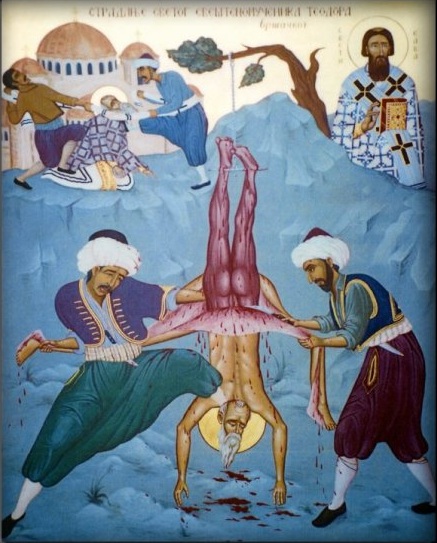 Capitolias is a city in Transjordan (near the Jordanian city of Irbid). Peter was a priest there, enjoying all the privileges of high status and wealth. He married when he was young, and had a son and two daughters. From his youth he devoted himself to studying the Holy Bible.
Capitolias is a city in Transjordan (near the Jordanian city of Irbid). Peter was a priest there, enjoying all the privileges of high status and wealth. He married when he was young, and had a son and two daughters. From his youth he devoted himself to studying the Holy Bible.
One day, Peter was meeting with Muslim elders, and he openly declared his faith in Christ before them and denounced them. The elders became angry with him and wanted to kill him. A disturbance occurred in the city because of him.
The Muslims sent a letter to Omar, son of the Caliph Al-Walid bin Abdul-Malik (705-715). Omar sent one of his officers to find out whether the accused was mentally impaired or had full mental faculties, in which case appropriate measures would be taken. The officer's name was false. He went to Capitolias and interrogated Peter, but found him awake and aware, fully aware of what he was saying. He put him in chains and placed him under strict guard, and ordered that no Christian should come near him. He also wrote the text of the interrogation and sent it to Omar to decide on his case.
Omar ordered that Peter the priest should be brought to Damascus to appear before him. And so it happened. Peter had been in the prison of Capitolias for more than a month. The next day after his arrival in Damascus, Omar brought him to him and said to him: “I know that when you were sick you uttered wicked words. I, for my part, attributed this to a disorder of your mind. But now you have recovered your health, and yet you are still falling into error. I have compassion on you, and I am giving you a chance to escape punishment. Confess that you have sinned. You may choose between life and death.”
But Peter's response was contrary to what Omar wanted. He ordered him to be sent to the Caliph, who issued a decree that he should be returned to his homeland, so that the inhabitants of Capitolia and the surrounding area, citizens and strangers, men, women and children, would be summoned, starting with the children and relatives of the condemned man. Then, when they arrived, the executioner would pull out his tongue from the depths. The next day, his right hand and foot would be cut off, and he would be left in torture all day. Then, on the third day, the Christians from those areas would be gathered, especially the priests and monks, and his other hand and foot would be cut off in front of them, and his eyes would be burned with hot iron. After that, he would be hung on the cross for five days, then the body, all the severed limbs, the clothes and the cross would be burned by fire, and the ashes would be scattered in the Yarmouk Lake, and traces of blood would be removed so that the Christians would have no remnants of him to keep as a relic.
When the time came for the execution of the sentence, the sentence was read out loud, and Peter answered with a loud voice with the last verse of Psalm 95: “…He is coming. He is coming to judge the earth.” Then he recited the entire Psalm 120: “…My help comes from the Lord, who made heaven and earth…”
As soon as he finished reciting it, his executioners began to carry out the sentence. They continued until they had completed everything the Caliph had ordered in full.
It was said that when his executioners wanted to take his body down from the cross, some pious believers came forward and took him on their shoulders, but the soldiers quickly removed them.
The martyrdom of Saint Peter took place on January 13, 715 AD. The Church commemorates him on the day of his martyrdom.


